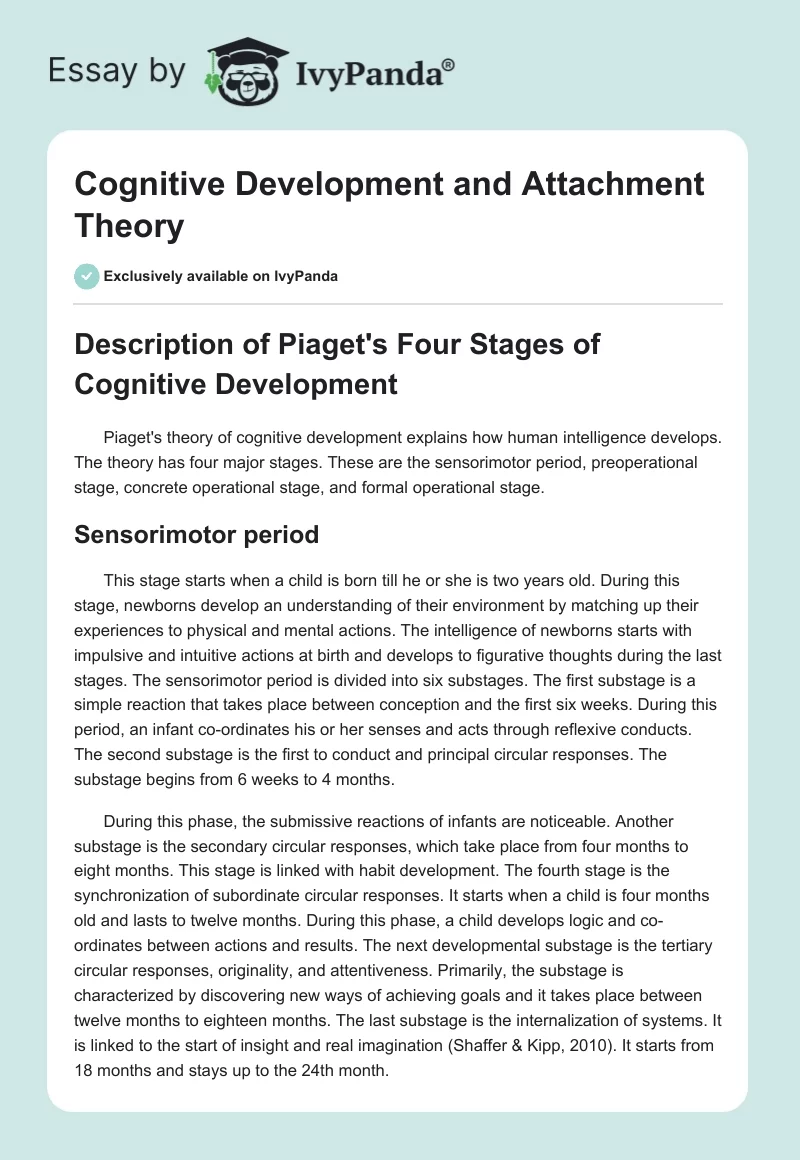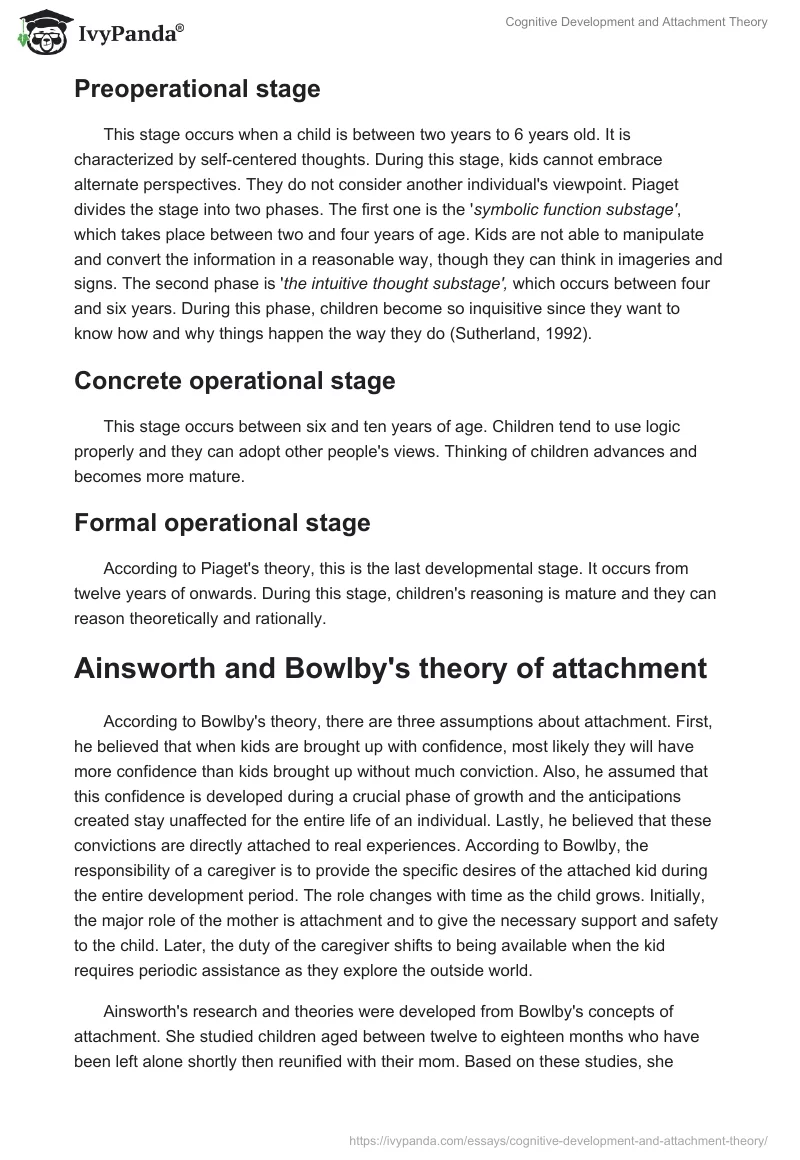Description of Piaget’s Four Stages of Cognitive Development
Piaget’s theory of cognitive development explains how human intelligence develops. The theory has four major stages. These are the sensorimotor period, preoperational stage, concrete operational stage, and formal operational stage.
Sensorimotor period
This stage starts when a child is born till he or she is two years old. During this stage, newborns develop an understanding of their environment by matching up their experiences to physical and mental actions. The intelligence of newborns starts with impulsive and intuitive actions at birth and develops to figurative thoughts during the last stages. The sensorimotor period is divided into six substages. The first substage is a simple reaction that takes place between conception and the first six weeks. During this period, an infant co-ordinates his or her senses and acts through reflexive conducts. The second substage is the first to conduct and principal circular responses. The substage begins from 6 weeks to 4 months.
During this phase, the submissive reactions of infants are noticeable. Another substage is the secondary circular responses, which take place from four months to eight months. This stage is linked with habit development. The fourth stage is the synchronization of subordinate circular responses. It starts when a child is four months old and lasts to twelve months. During this phase, a child develops logic and co-ordinates between actions and results. The next developmental substage is the tertiary circular responses, originality, and attentiveness. Primarily, the substage is characterized by discovering new ways of achieving goals and it takes place between twelve months to eighteen months. The last substage is the internalization of systems. It is linked to the start of insight and real imagination (Shaffer & Kipp, 2010). It starts from 18 months and stays up to the 24th month.
Preoperational stage
This stage occurs when a child is between two years to 6 years old. It is characterized by self-centered thoughts. During this stage, kids cannot embrace alternate perspectives. They do not consider another individual’s viewpoint. Piaget divides the stage into two phases. The first one is the ‘symbolic function substage’, which takes place between two and four years of age. Kids are not able to manipulate and convert the information in a reasonable way, though they can think in imageries and signs. The second phase is ‘the intuitive thought substage’, which occurs between four and six years. During this phase, children become so inquisitive since they want to know how and why things happen the way they do (Sutherland, 1992).
Concrete operational stage
This stage occurs between six and ten years of age. Children tend to use logic properly and they can adopt other people’s views. Thinking of children advances and becomes more mature.
Formal operational stage
According to Piaget’s theory, this is the last developmental stage. It occurs from twelve years of onwards. During this stage, children’s reasoning is mature and they can reason theoretically and rationally.
Ainsworth and Bowlby’s theory of attachment
According to Bowlby’s theory, there are three assumptions about attachment. First, he believed that when kids are brought up with confidence, most likely they will have more confidence than kids brought up without much conviction. Also, he assumed that this confidence is developed during a crucial phase of growth and the anticipations created stay unaffected for the entire life of an individual. Lastly, he believed that these convictions are directly attached to real experiences. According to Bowlby, the responsibility of a caregiver is to provide the specific desires of the attached kid during the entire development period. The role changes with time as the child grows. Initially, the major role of the mother is attachment and to give the necessary support and safety to the child. Later, the duty of the caregiver shifts to being available when the kid requires periodic assistance as they explore the outside world.
Ainsworth’s research and theories were developed from Bowlby’s concepts of attachment. She studied children aged between twelve to eighteen months who have been left alone shortly then reunified with their mom. Based on these studies, she suggested that there are 3 main systems of attachment. These are avoidant-insecure, secure, and ambivalent-insecure attachments. Research shows that these first attachment systems can aid in predicting an individual’s character later in life (Simpson, 1998). Secure attachment is characterized by misery when detached from the caregiver and happiness with the caregiver’s comeback. Children feel protected by their care provider for support. Children with an avoidant-insecure attachment develop a habit of avoiding their mothers or caregivers. These children will not show any preference of the mother to a stranger. According to Ainsworth, this kind of attachment may develop due to abusive or negligent care providers. In ambivalent-insecure attachments, children tend to be distressed when their caregivers are away. Studies show that this attachment is caused by poor parental availability. Children with ambivalent-insecure attachments cannot rely on their care providers to be available when in need. Later in life, the child may not need to depend on his or her caregiver.
References
Shaffer, R., & Kipp, K. (2010). Developmental psychology: Childhood and adolescence. Belmont, CA: Wadsworth Cengage Learning.
Simpson, A. (1998). Attachment theory and close relationships. New York, NY: Guilford Press.
Sutherland, P. (1992). Cognitive development today: Piaget and his critics. London: Chapman.


